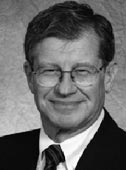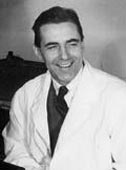Responsible Innovation
in Cardiac Surgery

Sidney Levitsky
|
Sid Levitsky, the David W.
and David Cheever Professor
of Surgery at Harvard Medical
School, began his Bigelow lecture
by describing the recent
transition in the common
understanding of the role of
physicians. In the distant past,
doctors were recognized as altruistic
and scholarly stewards of
the canon of medicine. In recent years the role of the
physician has been reinterpreted as similar to that of a
production worker. The language of a market civilization
comprised of providers and consumers associated with
this reinterpretation is clearly problematical.
17% of the gross domestic product of the United States
is consumed by healthcare, yet 49.9 million Americans
go without health insurance. Automobile manufacturers
in the United States spend more on health insurance
for their workers than they do on the steel that is put
into US cars. 30% of healthcare expenditures are consumed
by administration and 30% by defensive and non
evidence-based treatments. Though the wound infection
rate is reduced by 50% when antibiotics are properly
administered in the peri-operative period, there is only
23% compliance with this best practice.
43% of Medicare costs in the United States go to treatment
of cardiovascular disease. Levitsky showed a picture
of a balloon angioplasty from a publication in the
New England Journal of Medicine, showing a shower of
fragments from the disrupted coronary lesion - spreading
down stream and causing “infarctlets”. “It is not
CPK–washout, as cardiologists would have us believe,
but myocardial necrosis.” Hannan, in 2005, showed
evidence that the need for redo interventions when stenting
is used to treat coronary lesions far exceeds the need
for retreatment after coronary bypass (1). In the United
States there are currently 26% (formerly 11%) of cardiac
surgical units that perform fewer than 100 operations
per year. Clearly these were started in order to cover the
cardiologists who are inserting stents. Douglas reported
on 565,504 cardiac catheterizations (2). Disease was found
in 23-100% depending on the catheterization lab.
“Clinical behaviour is unaffected by guidelines”. For example,
evidence based guidelines counsel against attempting to
dilate occluded vessels. Nevertheless, this is routinely practiced.
The STS database now includes 4.5 million patients.
It is audited, covers 95% of hospitals performing open heart
surgery and has gained transparency by reporting results in
Consumer’s Reports. Whereas formerly 20% of surgeons
participated in public reporting, now 50% participate.
One group, the Virginia Cardiac Surgery Quality Initiative
group, has saved hundreds of millions of dollars through the
application of evidence.
The one year stroke rate in Transarterial Aortic Valve
Insertion (TAVI) patients is 8.3 % versus 4.3% in patients
treated with open aortic valve surgery. A study in Austria
using MRI, showed that 90% of TAVI patients had brain
lesions (resulting from fracture of calcified aortic valves in
order to make a place for the new prosthesis). Who should
do TAVI? It seems prudent to look at the STS database for
hospitals doing 2 or more aortic valve replacements per
week. The STS will recommend 150, not all 1100 cardiac
surgical centers, to do TAVI. The recommendation includes
training to improve the catheter and “wireskills” of surgeons,
and to require that two surgeons evaluate each case.
|
 Bill Bigelow
|
Wilfred (Bill) Bigelow was
a pioneer of cardiac surgery
who introduced the
use of hypothermia and
electrical stimulation of
the heart. He also introduced
the pacemaker to
Canadian surgery. His
trainees populated the surgical
programs throughout
Canada, and his lasting contributions in clinical
cardiac surgery, teaching, and research made him
a legend. The Bigelow Lectureship was created to
honour his memory and has brought distinguished
surgeons and scientists to the University of Toronto
for the past 5 years.
|
His overall theme was that evidence and transparency is
the new paradigm for effective medical care. He noted
that the problems with applying evidence based medicine
will be more difficult in the United States, a society
which evolved from a revolutionary culture, whereas
Canada evolved from an imperial culture.
Marv Tile asked “Who drives the industrial dominance,
for example, who advised Johnson & Johnson
on their recent decisions to stop manufacturing stents
and to buy an orthopedic device company?” Levitsky
answered that there are lots of roles and influences in
play including market and corporate values and “no
sheriff funded to enforce guidelines”. There is a need for
professionalism. We, the physicians, should advocate
for patients and traditional values. John Bohnen asked:
“Have advocacy groups a role?” The answer: “anecdotally
- they appear before congressional committees and
provide emotional testimony.” Tom Waddell asked:
“When brilliant innovators like Michael Mack come
up with new techniques, there is no evidence base of
randomized trials or meta-analyses to support them.”
Levitsky answered that we must make room for innovation
and participate in its oversight. Levitsky served
on the Lung Volume Reduction Surgery oversight
committee for the National Institutes of health Trial of
Emphysema Surgery. He has also served on Research
Ethics Boards and emphasized the need for US to serve
on such boards. He told us that Europe requires only
safety to be demonstrated for innovations, whereas
the United States requires safety and effectiveness. He
ended the discussion by telling us “We need to innovate
responsibly. Many IRBs inhibit innovation. I try to
counter this on the IRB at Harvard.” He closed with
Bigelow’s favourite quote, an aboriginal blessing: “May
the Great Spirit hold you in the palm of his hand!”
M.M.
1. Hannan, E., Racz, M.,Walford, G.,Jones, R., Thomas J.
Ryan, T., Bennett. E., Culliford, A., Isom, W., Gold, J.,
Rose, E. Long-Term Outcomes of Coronary-Artery Bypass
Grafting versus Stent Implantation. N Engl J Med 2005,
352:2174-2183
2. Douglas, P., Patel, M., Bailey, S., Dai D., Kaltenbach, L.,
Brindis, R., Messenger, J., Peterson, E. Hospital Variability
in the Rate of Finding Obstructive Coronary Artery Disease
at Elective, Diagnostic Coronary Angiography. J Am Coll
Cardiol, 2011; 58:801-809.
|